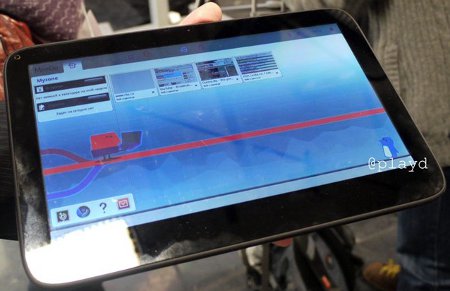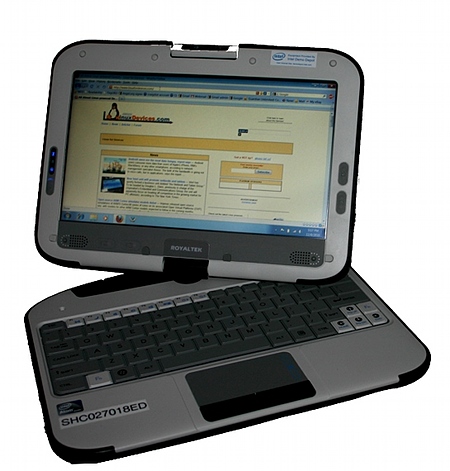New Intel unit will promote netbooks and tablets
Dec 8, 2010 — by LinuxDevices Staff — from the LinuxDevices Archive — viewsIntel has quietly formed a business unit dubbed “the Netbook and Tablet Group.” To be headed by Douglas L. Davis, previously in charge of the chipmaker's Embedded and Communications Group, the unit will apparently focus on heading off competition in the growing market for PC offshoots, according to The New York Times.
As Times technology writer Ashlee Vance noted this morning, Intel usually formally announces the creation of new groups, but "kept this one quiet for some reason." Still, he adds, it has now been formally confirmed.
Intel spokesperson Bill Kircos was quoted as saying, "Netbook shipments will be heading north of 100 million and we'll all soon will find out what kind of market potential there is for tablets and these increasingly popular hybrid designs. It makes sense for us to sharpen our focus on these friends of the PC."
 Vance's story adds that Intel's Netbook and Tablet Group will be headed by Douglas L. Davis, who has been the head of the chip giant's Embedded and Communications Group since 2005. According to Intel, Davis (right) has previously held roles including being general manager of its Embedded Microcomputer Division, its Network Processor Division, and its Infrastructure Processor Division, which formed from the consolidation of all of Intel's embedded processor efforts.
Vance's story adds that Intel's Netbook and Tablet Group will be headed by Douglas L. Davis, who has been the head of the chip giant's Embedded and Communications Group since 2005. According to Intel, Davis (right) has previously held roles including being general manager of its Embedded Microcomputer Division, its Network Processor Division, and its Infrastructure Processor Division, which formed from the consolidation of all of Intel's embedded processor efforts.
It appears that no successor for Davis in the Embedded and Communications Group has yet been named. Kircos, meanwhile, reportedly told Vance, "Doug's experience running a similar and very successful embedded division makes him the right guy to lead the group."
As he helms the Netbook and Tablet Group, Davis will face the same key issue as he has with Embedded: namely, keeping Intel and its x86 offerings competitive against ARM Holdings and its many licensees. Apple's successful iPad — and the many Android-based tablets that have begun to follow — show that, so far, customers are more interested in long battery life and simplified user interfaces than they are in compatibility with Microsoft Windows and other x86-specific software.
Intel doubtless hopes that its power-sipping Oak Trail Atom, set for release next year, will narrow the gap. Company CEO Otellini drew a contrast between the Atom and its hordes of ARM-based competitors in an October conference call, noting that over the next few quarters, there will be a host of new Atom-powered tablets running the Windows, Android, and MeeGo operating systems — three of the top four tablet OSes.

MeeGo-based WeTab
Last week, Engadget reported briefly on the sighting of a MeeGo-based tablet (pictured below) at an Intel event held in Moscow. No details were offered on the tablet, which appears to be in the 10-inch range. At the same event, Intel showed a MeeGo-based "Hi/Lo Vibrant" smartphone, says the story.

Mystery MeeGo tablet at Intel event in Moscow
Source: Engadget
Meanwhile, journalists often ignore the fact that Intel's original Atom, the Z5xx, was originally designed with embedded devices in mind — not netbooks or tablets. Meanwhile, Z5xx-based mobile Internet devices (MIDs) — essentially small, 4-5-inch tablets — running the Intel-backed Moblin stack largely failed in the market. (Moblin, of course, is the main source for MeeGo, along with Nokia's Maemo Linux.)
Yet, the chipmaker later spun a lower-cost (but also slightly more power-hungry) version, the N270, for "netbooks" and "nettops," and the rest is history.
As Vance notes in his Times story, netbooks boosted the PC market overall, and also boosted Intel's long-standing push in the education market. He cites the example of the San Diego public school system, which has purchased 35,000 netbooks for third and fourth graders and is expected to buy 100,000 more as it expands a program aimed at giving all students access to computers.

Intel's Classmate design is produced by a variety of OEMs
Intel first introduced its Classmate mini-laptop (later rechristened as a netbook) for kids in March 2007, employing a 900MHz Celeron CPU. The device later switched to the N270 and also gained an option of a screen that pivots and folds down into a tablet configuration. (In its latest version, pictured above and below, the device is available with a 1366 x 768 pixel screen and a 1.66GHz Atom N450 CPU.)

The Classmate in tablet mode
Meanwhile, Intel announced in September 2009 a netbook-focused "AppUp" applications store as part of its Atom Developer program. The chipmaker later released an AppUp SDK — promising developers they could use C or C++ to create apps that would execute on Atom netbooks running either Windows or Moblin, thanks to a cross-platform runtime — and opened the store to consumers in September of this year.
Further information
More information on Intel's Classmate and AppUp store may be found here and here, respectively.
This article was originally published on LinuxDevices.com and has been donated to the open source community by QuinStreet Inc. Please visit LinuxToday.com for up-to-date news and articles about Linux and open source.